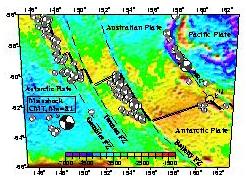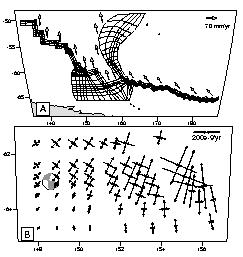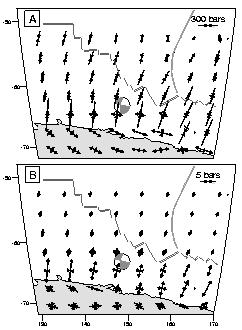What Caused the March 25, 1998 Antarctic Plate Earthquake?:
Inferences from Regional Stress and Strain Rate Fields
Corné Kreemer, and
William Holt (SUNY Stony Brook)
Paper in GRL is available here
We investigate possible driving forces behind the occurrence of the 1998 Antarctic
plate earthquake. We determine first a regional strain rate field associated
with the accommodation of relative plate motion, and second, a vertically averaged
minimum deviatoric stress field associated with lithospheric gravitational potential
energy differences and deglaciation of the Antarctic ice cap. We find that the
mechanism of this event is inconsistent with strain orientations inferred from
kinematic modeling of a diffuse zone of deformation within the triple junction
region. Stress perturbations associated with deglaciation cannot be ruled out
as a triggering mechanism for this event.
 Figure 1. Focal mechanisms are from the Harvard CMT catalog (1/77-6/99).
The black focal mechanisms indicate the 1998 Antarctic plate event with
(some of) its aftershocks. Bathymetry is from Smith and Sandwell [1994].
Transform locations are derived from satellite altimetry by Spitzak and DeMets [1996].
MRC is the Macquarie Ridge Complex and TJ is the Australia-Pacific-Antarctica triple junction.
Figure 1. Focal mechanisms are from the Harvard CMT catalog (1/77-6/99).
The black focal mechanisms indicate the 1998 Antarctic plate event with
(some of) its aftershocks. Bathymetry is from Smith and Sandwell [1994].
Transform locations are derived from satellite altimetry by Spitzak and DeMets [1996].
MRC is the Macquarie Ridge Complex and TJ is the Australia-Pacific-Antarctica triple junction.

Figure 2. a) Grid in which a strain rate field is determined associated with
the accommodation of relative plate motions [DeMets et al., 1994].
These motions are applied as boundary velocity conditions, illustrated by the grey arrows.
b) Principal axes of the strain rate field for the region where the Antarctic event
occurred (indicated by CMT focal mechanism). Model strain rates in this region are one order of
magnitude lower than along the surrounding ridges and transforms.

Figure 3. a) Principal axes of the vertically averaged minimum horizontal deviatoric stress
field caused by gravitational potential energy differences within the lithosphere. CMT focal mechanism
of Antarctic plate earthquake is shown. a) 'ice-age' simulation.
b) change in stress tensor field from 'ice-age' to present day determined by taking the
tensorial difference between the two solutions.
 Click here for Paper abstract
Click here for Paper abstract
 Figure 1. Focal mechanisms are from the Harvard CMT catalog (1/77-6/99).
The black focal mechanisms indicate the 1998 Antarctic plate event with
(some of) its aftershocks. Bathymetry is from Smith and Sandwell [1994].
Transform locations are derived from satellite altimetry by Spitzak and DeMets [1996].
MRC is the Macquarie Ridge Complex and TJ is the Australia-Pacific-Antarctica triple junction.
Figure 1. Focal mechanisms are from the Harvard CMT catalog (1/77-6/99).
The black focal mechanisms indicate the 1998 Antarctic plate event with
(some of) its aftershocks. Bathymetry is from Smith and Sandwell [1994].
Transform locations are derived from satellite altimetry by Spitzak and DeMets [1996].
MRC is the Macquarie Ridge Complex and TJ is the Australia-Pacific-Antarctica triple junction.

